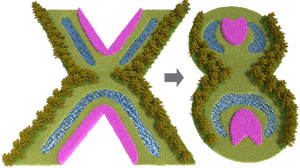Information
- Publication Type: Journal Paper (without talk)
- Workgroup(s)/Project(s):
- Date: August 2018
- DOI: 10.1109/TVCG.2017.2730877
- ISSN: 1077-2626
- Journal: IEEE Transactions on Visualization and Computer Graphics
- Number: 8
- Open Access: no
- Volume: 24
- Pages: 2327 – 2338
- Keywords: shape matching, transformations, shape similarity
Abstract
Finding similar points in globally or locally similar shapes has been studied extensively through the use of various point descriptors or shape-matching methods. However, little work exists on finding similar points in dissimilar shapes. In this paper, we present the results of a study where users were given two dissimilar two-dimensional shapes and asked to map a given point in the first shape to the point in the second shape they consider most similar. We find that user mappings in this study correlate strongly with simple geometric relationships between points and shapes. To predict the probability distribution of user mappings between any pair of simple two-dimensional shapes, two distinct statistical models are defined using these relationships. We perform a thorough validation of the accuracy of these predictions and compare our models qualitatively and quantitatively to well-known shape-matching methods. Using our predictive models, we propose an approach to map objects or procedural content between different shapes in different design scenarios.Additional Files and Images
Weblinks
BibTeX
@article{HECHER-2017-HDY,
title = "How Do Users Map Points Between Dissimilar Shapes?",
author = "Michael Hecher and Paul Guerrero and Peter Wonka and Michael
Wimmer",
year = "2018",
abstract = "Finding similar points in globally or locally similar shapes
has been studied extensively through the use of various
point descriptors or shape-matching methods. However, little
work exists on finding similar points in dissimilar shapes.
In this paper, we present the results of a study where users
were given two dissimilar two-dimensional shapes and asked
to map a given point in the first shape to the point in the
second shape they consider most similar. We find that user
mappings in this study correlate strongly with simple
geometric relationships between points and shapes. To
predict the probability distribution of user mappings
between any pair of simple two-dimensional shapes, two
distinct statistical models are defined using these
relationships. We perform a thorough validation of the
accuracy of these predictions and compare our models
qualitatively and quantitatively to well-known
shape-matching methods. Using our predictive models, we
propose an approach to map objects or procedural content
between different shapes in different design scenarios.",
month = aug,
doi = "10.1109/TVCG.2017.2730877",
issn = "1077-2626",
journal = "IEEE Transactions on Visualization and Computer Graphics",
number = "8",
volume = "24",
pages = "2327--2338",
keywords = "shape matching, transformations, shape similarity",
URL = "https://www.cg.tuwien.ac.at/research/publications/2018/HECHER-2017-HDY/",
}


 draft
draft
